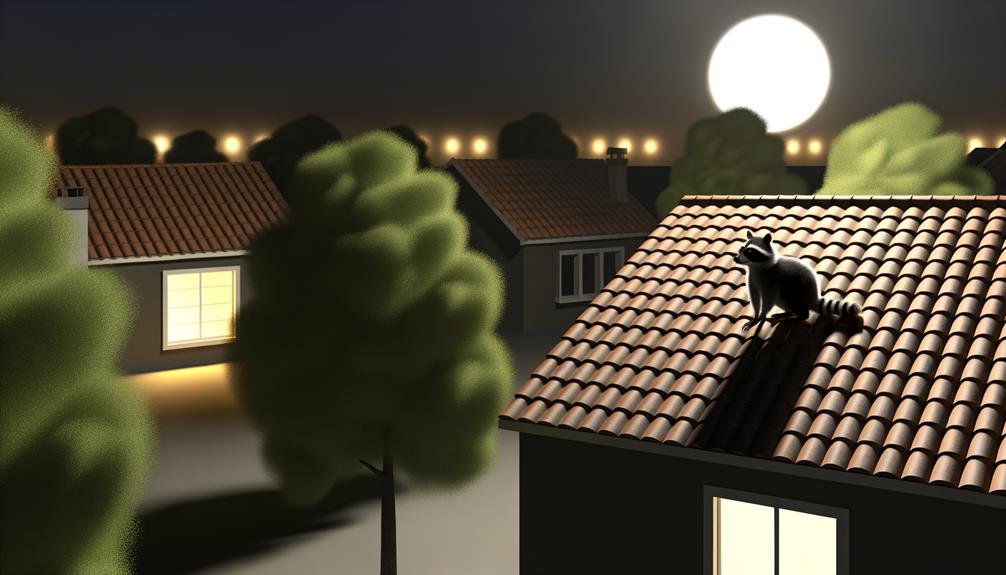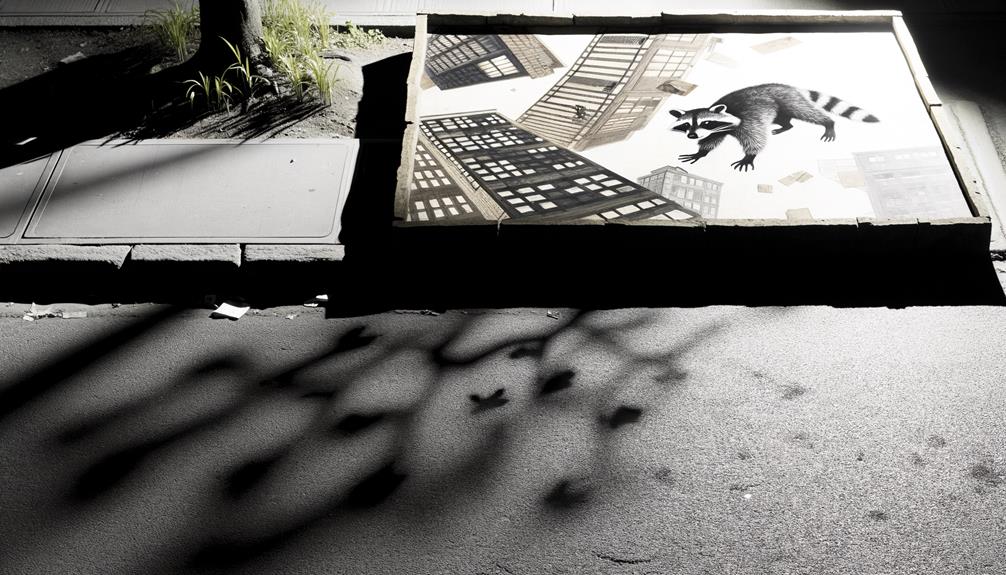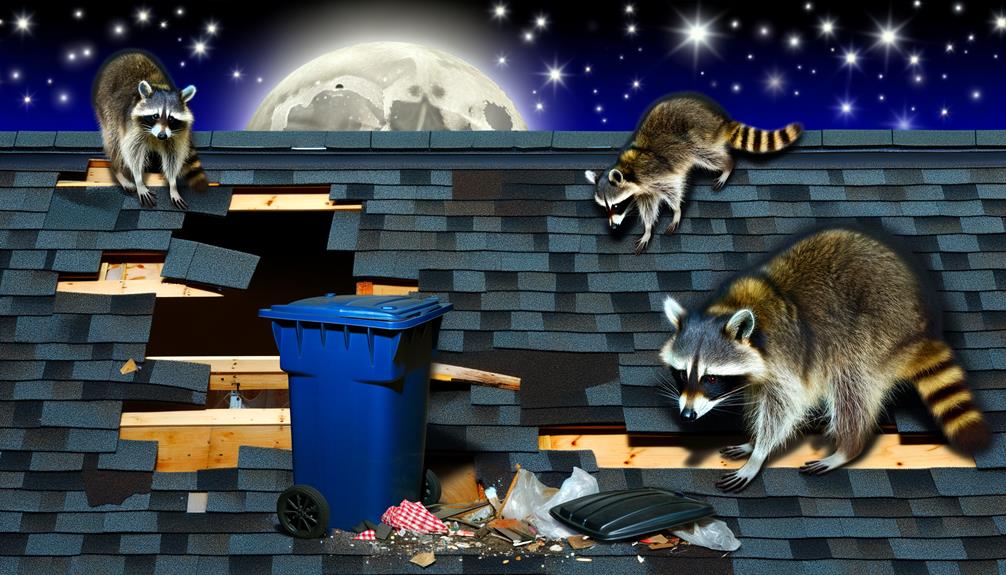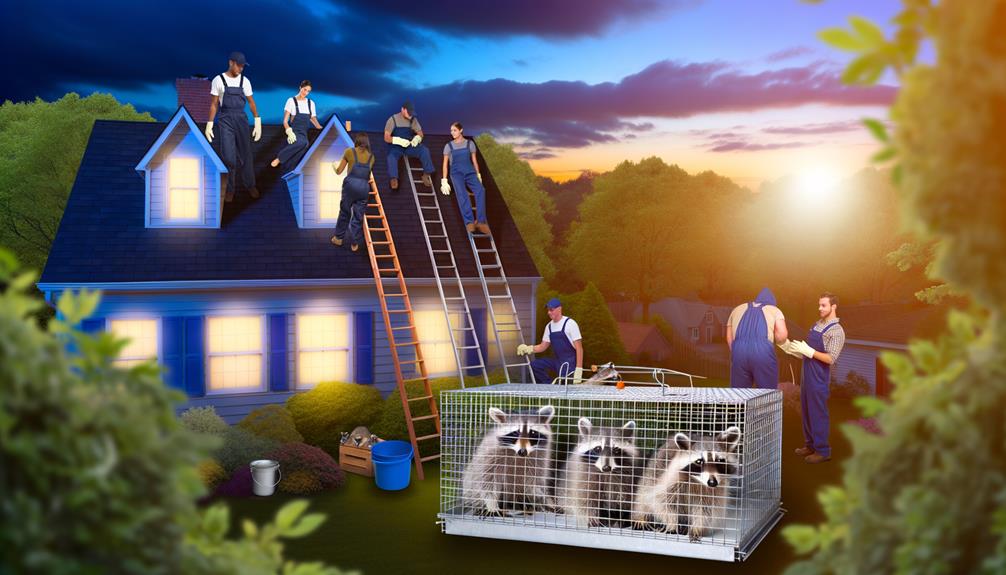Why Do Raccoons Live on Roofs?
Raccoons are adept climbers, utilizing rooftops for nesting and foraging due to the strategic advantageous points they offer. These animals often nest in attics or under eaves, and their nocturnal habits bring them close to human dwellings.
Structural vulnerabilities such as chimneys, vents, and roof gaps provide entry points for raccoons. Signs of their presence include noise patterns, droppings, and physical damage like torn shingles or gnawed components.
Understanding the behavior and habitat preferences of raccoons, particularly in urban environments, is vital for effective management and mitigation of potential damage. Discover more insights about raccoon prevention methods and humane removal options.

Key Takeaways
- Raccoons often live on roofs due to safety and easy access to food sources.
- Rooftops offer raccoons a strategic vantage point for surveying territory.
- Common entry points include chimneys, vents, and roof gaps.
- Signs of raccoons on roofs include noise, droppings, and physical damage.
- Preventing roof access involves securing entry points and trimming overhanging branches.
Raccoon Roof Habits

Raccoons exhibit distinct behaviors when residing on rooftops, often utilizing these elevated spaces for nesting, foraging, and evading predators. Research indicates that rooftops provide a strategic vantage point, offering safety from terrestrial threats and facilitating access to food resources.
Nests, or dens, are typically constructed in secluded areas such as attics or under eaves, where raccoons find protection from environmental elements. Their nocturnal foraging habits are supported by the proximity to human dwellings, which often offer ample food sources like garbage or pet food.
Behavioral studies reveal that raccoons are adept climbers, using gutters, downspouts, and adjacent trees to access rooftops. This adaptability underscores their synanthropic nature, highlighting their ability to thrive in anthropogenic landscapes.
Urban Vs. Rural Environments
Frequently, the behavioral patterns and habitat preferences of raccoons exhibit significant variation between urban and rural environments. Urban raccoons often adapt to human presence, utilizing resources like garbage bins and sheltering in man-made structures. Conversely, rural raccoons are more reliant on natural food sources and habitats, such as forests and streams. This dichotomy in environmental adaptation is evident in their foraging behaviors and nesting preferences.
| Environment | Raccoon Behavior |
|---|---|
| Urban | Utilizes garbage bins |
| Urban | Shelters in buildings |
| Rural | Forages in forests |
| Rural | Nests in natural sites |
Understanding these distinctions aids in comprehending raccoon ecology and guiding urban wildlife management strategies. This knowledge also underscores the raccoon's remarkable adaptability to diverse habitats.
Reasons for Rooftop Living

Driven by the search for safety and readily available food sources, raccoons often choose rooftops as preferred nesting sites. This behavior is primarily attributed to the elevated position providing a strategic advantage against predators.
Rooftops offer a secluded environment, minimizing the risk of terrestrial threats such as dogs or coyotes. Moreover, urban settings frequently present an abundance of food sources, from unsecured garbage bins to pet food left outside. Studies indicate that raccoons exhibit remarkable adaptability and problem-solving abilities, enabling them to exploit these food resources efficiently.
Additionally, rooftops provide an excellent vantage point for surveying their territory, enhancing their ability to locate food and detect potential threats. This combination of safety and sustenance makes rooftops an attractive habitat for urban raccoons.
Common Entry Points
Raccoons frequently exploit structural vulnerabilities in rooftops as entry points into residential and commercial buildings. Commonly utilized access points include chimneys and vents, which often lack adequate barriers to prevent wildlife intrusion.
Additionally, roof gaps created by construction flaws or material degradation provide raccoons with unobstructed pathways to interior spaces.
Chimneys and Vents
Chimneys and vents often serve as accessible entry points for raccoons seeking shelter, due to their structural openings and relative ease of access. These entry points provide a protected environment that raccoons find attractive for nesting and denning. Empirical evidence suggests that the presence of raccoons in these areas can lead to significant structural damage and potential health risks due to fecal contamination.
| Entry Point | Common Issues |
|---|---|
| Chimneys | Nesting, blockages, damage |
| Roof Vents | Entry for shelter, damage |
| Attic Vents | Nesting, insulation damage |
Homeowners are advised to install raccoon-proof caps and screens to mitigate these risks. Regular maintenance and inspections are crucial to make certain these entry points do not become habitats for wildlife.
Roof Gaps
Although often overlooked, roof gaps constitute a significant entry point for raccoons, facilitating their access to attics and other interior spaces. These agile creatures exploit even the smallest structural vulnerabilities, often leading to significant human-wildlife conflicts. Research indicates that raccoons can squeeze through openings as small as 3 to 4 inches.
Common roof gaps include:
- Eaves: Spaces where the roof meets the walls can be easily breached.
- Fascia boards: Deteriorating or loose boards provide accessible entry points.
- Roof vents: Improperly sealed vents offer pathways into interior spaces.
- Roof intersections: Complex roofline intersections create gaps due to construction variances.
Seal these potential entry points with durable materials to mitigate raccoon intrusions effectively. Regular inspection and maintenance are essential preventative measures.
Signs of Raccoons on Roofs

Identifying the presence of raccoons on roofs involves observing specific indicators such as:
- Nocturnal noise patterns
- Physical damage to roofing materials
- The presence of droppings and tracks
These signs are critical for timely detection and subsequent management of raccoon infestations. Analyzing these factors can provide insights into the severity and extent of the issue.
Nocturnal Noise Patterns
Nocturnal noise patterns, characterized by scratching, thumping, and vocalizations, provide critical auditory evidence of raccoons inhabiting roof spaces. These nocturnal creatures are most active after dusk, and their movements within attic and roof areas often produce distinctive sounds that can be systematically identified.
Key indicators include:
- Scratching: Often intermittent, can signify raccoons moving or nesting.
- Thumping: Sudden, sharp noises that correlate with raccoons jumping or shifting positions.
- Vocalizations: Chittering or growling sounds, indicative of communication between raccoons.
- Scurrying: Rapid, light-footed movements suggesting raccoon activity.
This auditory data, when analyzed, can help homeowners and wildlife professionals confirm the presence of raccoons without direct visual confirmation, thereby facilitating timely and appropriate interventions.
Roof Damage Indicators
Evidence of raccoons residing on roofs can be discerned through specific indicators of structural damage, such as torn shingles, displaced insulation, and gnawed wooden components. These physical manifestations are often the result of raccoons seeking entry points or attempting to create nests.
Torn shingles are a common sign, as raccoons possess the strength to lift and tear roofing materials to gain access to attics. Displaced insulation may indicate nesting behavior within roof spaces, while gnawed wooden components, such as soffits and fascia boards, point to efforts to expand entryways.
Regular inspection of these elements can provide early detection of raccoon activity, reducing potential long-term damage and facilitating timely intervention.
Droppings and Tracks
Raccoon presence on roofs can be confirmed through the identification of distinctive droppings and tracks, which serve as reliable indicators of their activity. Raccoon droppings are typically dark, tubular, and segmented, often containing visible remnants of their varied diet. Tracks left by raccoons are also distinctive, with five elongated toes on each paw, resembling small human handprints. Observing these signs can assist in confirming raccoon activity without direct visual contact.
Recognizable signs include:
- Droppings: Dark, tubular, segmented with dietary remnants.
- Tracks: Five elongated toes resembling small human handprints.
- Scratch Marks: Frequently found near entry points.
- Nesting Material: Leaves, twigs, and insulation gathered on the roof.
Such evidence provides a scientific basis for determining raccoon activity on roofs.
How Raccoons Climb
With their highly dexterous front paws and sharp claws, raccoons are adept climbers capable of scaling various surfaces with remarkable ease. This climbing proficiency is facilitated by their semi-plantigrade stance, allowing their hind legs to rotate 180 degrees, enabling descent from vertical structures head-first. Evidence indicates that raccoons can ascend trees, fences, and even walls with textured surfaces.
Their muscular limbs and flexible joints contribute to their impressive agility. Additionally, raccoons possess acute tactile sensitivity in their paws, aiding in gripping and traversing complex terrains. Such anatomical and physiological adaptations enable raccoons not only to access roofs but also to exploit these elevated environments for shelter and foraging opportunities, thereby complicating human-wildlife interactions.
Risks of Raccoons on Roofs

The ability of raccoons to access rooftops introduces significant risks, including structural harm, potential for disease transmission, and increased human-wildlife conflicts. These nocturnal mammals are known to cause substantial harm to roofing materials, insulation, and electrical wiring, thereby compromising the structural stability of buildings.
Additionally, raccoons are carriers of various pathogens, such as leptospirosis and raccoon roundworm, which pose health risks to humans and pets. Their presence can also escalate conflicts, leading to stressful encounters and potential injuries.
- Structural harm: Raccoons can tear shingles and create entry points.
- Disease transmission: They carry zoonotic diseases.
- Electrical hazards: Chewing on wiring can lead to fires.
- Human-wildlife conflicts: Increased interaction can result in aggressive behavior.
Understanding these risks is essential for effective management.
Preventing Roof Access
Implementing effective measures to prevent raccoons from accessing roofs is essential for minimizing the associated risks and ensuring structural integrity. Evidence-based strategies include securing potential entry points such as vents, chimneys, and gaps in the fascia using durable materials like metal mesh.
Additionally, trimming overhanging tree branches can deter raccoons from using them as pathways to the roof. Installing motion-activated lights or sprinklers can also serve as deterrents by creating an inhospitable environment.
Regular roof inspections are recommended to identify and rectify vulnerabilities promptly. Research indicates that combining multiple preventive techniques increases efficacy, thereby reducing the likelihood of raccoon intrusion.
Employing these measures is critical for maintaining the safety and durability of residential and commercial properties.
Humane Removal Methods

Utilizing humane removal methods for raccoons involves employing non-lethal techniques that prioritize the well-being of the animals while ensuring they are safely relocated. Scientific literature suggests that these strategies are effective in mitigating harm to raccoons and reducing human-wildlife conflict.
Key methods include:
- Live trapping: Utilizing cage traps to capture raccoons without injury, followed by relocation to a suitable habitat.
- Exclusion devices: Installing one-way doors that allow raccoons to exit but prevent re-entry.
- Repellents: Applying non-toxic deterrents that encourage raccoons to vacate the area voluntarily.
- Habitat modification: Removing food sources and securing entry points to make the environment less attractive to raccoons.
These approaches are supported by evidence indicating their efficacy and ethical consideration.
Repairing Roof Damage
Repairing roof damage caused by raccoons necessitates a thorough assessment to identify compromised structural elements, such as shingles, underlayment, and insulation. Evidence-based repair techniques include replacing damaged materials and reinforcing weak points to prevent future infestations.
Objective analysis of repair outcomes can guide improvements in both methodology and materials used.
Identifying Roof Damage
Identifying roof damage caused by raccoons involves examining common signs such as torn shingles, displaced vents, and damaged eaves. Raccoons, being agile climbers, can inflict significant damage while searching for entry points or nesting locations. Understanding these signs is vital for timely intervention and prevention of further deterioration.
Key indicators of raccoon-related roof damage include:
- Torn Shingles: Raccoons often pry up shingles to gain access.
- Displaced Vents: Vents can be shifted or removed entirely as raccoons attempt entry.
- Damaged Eaves: Structural components like eaves may exhibit claw marks or bite marks.
- Scattered Debris: Roofing materials and insulation can be found scattered around the area.
Early detection through these signs enables effective management and mitigation of raccoon-related roof damage.
Effective Repair Techniques
Once roof damage caused by raccoons has been identified, implementing effective repair techniques is essential to restore the structural integrity of the roof and prevent further intrusions.
Initial assessment should involve a thorough examination of the affected areas to determine the extent of damage. High-quality materials such as galvanized steel mesh can be used to reinforce vulnerable entry points. Sealants and roof patches must be applied to repair any holes or cracks.
Additionally, ensuring proper ventilation is vital to prevent moisture buildup, which could exacerbate structural weaknesses. Regular maintenance and inspections can preempt potential issues, thereby safeguarding against future raccoon intrusions.
Employing professional roofing services guarantees adherence to industry standards, ensuring long-term durability and resilience.
Legal Considerations

Understanding the legal considerations surrounding raccoons living on roofs is vital for property owners to ensure compliance with local wildlife management and property laws. Jurisdictions often have specific regulations that address the humane treatment, capture, and relocation of wildlife. These regulations guarantee the protection of raccoons while balancing property rights and public health concerns.
Key legal considerations include:
- Permits and Licensing: Some areas require permits for trapping and relocating raccoons.
- Protected Status: Regulations may vary if raccoons are classified as protected species.
- Methods of Control: Legal methods for exclusion or deterrence must adhere to animal welfare standards.
- Health and Safety: Compliance with public health regulations, particularly regarding zoonotic disease risks.
Familiarizing oneself with local laws is essential for ethical and legal wildlife management.
Professional Help Options
Engaging expert wildlife control services can offer effective and compassionate solutions for dealing with raccoons residing on roofs. These specialists utilize scientifically validated methods to guarantee the safe removal and exclusion of raccoons. Evidence shows that professional intervention reduces the likelihood of property damage and potential health risks associated with raccoon infestations.
| Service Type | Description |
|---|---|
| Examination | Thorough assessment of the property |
| Exclusion | Installing barriers to prevent re-entry |
| Humane Removal | Safe trapping and relocation of raccoons |
Objective analysis reveals that professionals utilize exclusion techniques, such as sealing entry points, which are more efficient than DIY methods. Additionally, these services often include follow-up inspections to confirm the durability of the solution, hence preserving the structural integrity of the roof.
Conclusion
The prevalence of raccoons on roofs in both urban and rural environments can be attributed to the availability of food and shelter. Key indicators of their presence include noise and damage, necessitating humane removal and subsequent repair.
How can property owners guarantee long-term exclusion of these adaptable creatures? Implementing preventative measures and seeking professional assistance are critical steps. Understanding and addressing the behavioral tendencies and entry points of raccoons are essential for effective management.





